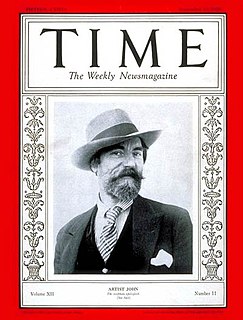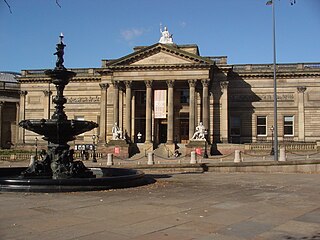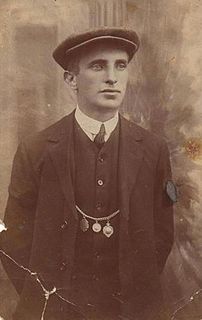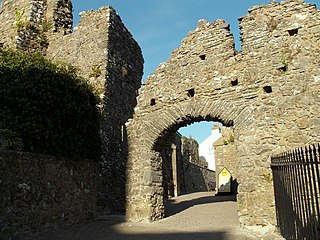
Augustus Edwin John was a Welsh painter, draughtsman, and etcher. For a time he was considered the most important artist at work in Britain: Virginia Woolf remarked that by 1908 the era of John Singer Sargent and Charles Wellington Furse "was over. The age of Augustus John was dawning." He was the younger brother of the painter Gwen John.

Pembrokeshire is a county in the south-west of Wales. It is bordered by Carmarthenshire to the east, Ceredigion to the northeast, and the rest by sea. The county is home to Pembrokeshire Coast National Park. The Park occupies more than a third of the area of the county and includes the Preseli Hills in the north as well as the 190-mile (310 km) Pembrokeshire Coast Path.

The Walker Art Gallery is an art gallery in Liverpool, which houses one of the largest art collections in England outside London. It is part of the National Museums Liverpool group.

Tenby is both a walled seaside town in Pembrokeshire, Wales, on the western side of Carmarthen Bay, and a local government community.
Graham Vivian Sutherland was a prolific English artist. Notable for his paintings of abstract landscapes and for his portraits of public figures, Sutherland also worked in other media, including printmaking, tapestry and glass design.

Charles Norris was an English topographical etcher and writer who is best known for his landscape work of the Welsh countryside, especially the area around Tenby.

Narberth is both a town and a community in Pembrokeshire, Wales. It was founded around a Welsh court and later became a Norman stronghold on the Landsker Line. It became the headquarters of the hundred of Narberth. It was once a marcher borough. George Owen described it in 1603 as one of nine Pembrokeshire "boroughs in decay".

Penally coastal village, parish and community 1 mile (1.6 km) southwest of Tenby in Pembrokeshire, Wales. The village is known for its Celtic Cross, Penally Abbey, the neighbouring St. Deiniol's Well, WWI Practice trenches, and Penally Training Camp. In the community, though nearer to St Florence than Penally, is Carswell Medieval House, a Grade II* listed building.

Stirling Smith Art Gallery and Museum, formerly The Smith Institute, is an art and local history museum in Stirling, Scotland. The museum was founded in 1874 at the bequest of artist Thomas Stuart Smith.

Frederick Charles "Tenby" Davies was a Welsh athlete who became the half-mile world professional champion in 1909 after a race against Irishman Beauchamp Day.

Tenby Castle was a fortification standing on a headland separated by an isthmus from the town of Tenby, Pembrokeshire, Wales. The remaining stone structure dates from the 13th century but there are mentions of the castle from as early as 1153. It is a Grade II* listed building.
Barry John MBE is a Welsh soldier and artist. He served in the British armed forces for over 20 years. In the 2010 New Years Honours List Barry John was awarded the MBE. He is mainly an abstract artist. Through his work he expresses stories, memories, demons, harsh and sometimes brutal truths and the beauty, colours and resilience of a conflicted world.
David Burton-Richardson is a Welsh artist and poet. He has works in many public and private collections worldwide. The David Burton-Richardson Collection and Archive is housed at Scolton Manor museum near Haverfordwest, Pembrokeshire. The publication 'From Now to Zero' is housed within the library collections of the Tate Gallery, National Library of Wales and the Kohler Art Library, Wisconsin, USA. In more recent years he has been inspired by the Welsh Valleys, which inspire his abstract works.
John Uzzell Edwards was a Welsh painter. He was also the father of artist Charles Uzzell Edwards.

Shrewsbury Museum and Art Gallery was founded in 1835 as the Museum of the Shropshire and North Wales Natural History and Antiquarian Society Society in Dogpole, Shrewsbury, England. In 1853 the collections were moved to Vaughan's Mansion on College Hill, which became known as the Shropshire and North Wales Museum. After 160 years and two subsequent homes the museum returned to Vaughan's Mansion and the Music Hall Complex after a major redevelopment of the site.
St Mary Out Liberty is a community in the southeast of Pembrokeshire, Wales. The community was established in 1974 under changes in local government organisation and has its own community council. It is included, with St Mary In Liberty, in the parish of Tenby. The community includes the villages of New Hedges, Gumfreston plus a small part of Saundersfoot.
Allen's of Tenby was a firm of photographers established in "The Excelsior Studio", a photography studio at 1 Campbell House, High Street, Tenby, Pembrokeshire, opened by Harry Mortimer Allen (1864-1926) in 1890. In 1896, the studio was renamed "The Campbell Studio". Mortimer specialised in portraiture and landscapes. He was also a dealer in fine art and a picture framer. He also took "occasion" photographs and postcard images of Tenby and other local districts. In addition to black and white, he made colour-tinted postcards.

John Thackray Bunce was a British journalist and author. He served as editor of Aris's Birmingham Gazette from 1860 to 1862, and of the Birmingham Post from 1862 to 1898.

The Tenby Observer is a weekly English language newspaper, published each Friday, which circulates around Tenby, South Pembrokeshire, and amongst tourists generally. The ’paper started as a list of the town's influential and well-to-do visitors but soon added news, mostly local, and adverts which traditionally adorned the front page. It was published by Richard Mason from 1853 to 1860.
Fanny Price-Gwynne was a Welsh novelist, artist, composer, poet and philanthropist. She was a prominent figure in Victorian society, born in the Pembrokeshire town of Tenby. From childhood, Fanny Price had a love of the sea, largely because her father was a Royal Navy master and a trustee of the Tenby charities. He also served the management of the Royal National Lifeboat Institution, and put the first tide tables in the Tenby Observer newspaper. Her mother worked as the local correspondent for the Carmarthen Journal newspaper, and therefore likely encouraged her daughter to take up writing herself.















